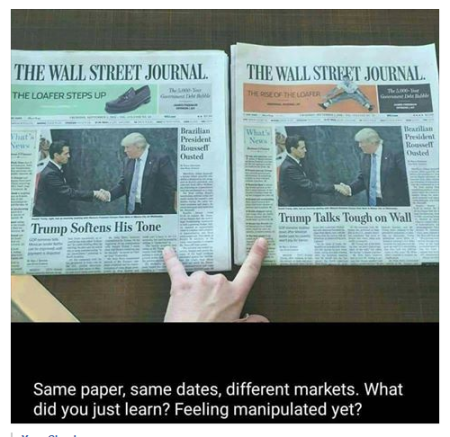The sudden global interest in “fake news” sparked by the US elections and allegations of Russian interference to support Trump’s campaign has led several IA readers to contact me asking why both the mainstream media and the alternative social journalism sphere both seem to lie with impunity, or at least are prepared to promote unverified rumour as actual news.
I’ve attempted to provide some answers in recent weeks in terms of the so-called “post-truth” media landscape, the widespread dissemination of propaganda in the guise of independent reporting and the deliberate misinformation spread by both the Clinton and the Trump camps during the election season.
But it seems that these are only partial explanations that deal with the surface issues and practicalities, without delving deeper into the psychological, philosophical and intellectual roots of the problem. This week I thought I might attempt to answer some of these more puzzling questions.
It must be true, it’s on Facebook
A good example of the confusing feedback loop between journalism and social media is this illustration, which was sent to me by a friend on Facebook. How do we account for this deliberate attempt to tailor perspectives and expectations when it is done by a so-called “respectable” publication, the Wall Street Journal?
The ‘Trump softens his tone’ headline was for the New York market, which is more soft-l liberal and therefore inclined not to like the idea of Trump’s wall. The ‘Trump talks tough on wall’ headline was for the Texas edition of the WSJ. In Texas there is likely to be more support for the idea of a wall on the border with Mexico. This manipulation might be simply about pandering to a particular demographic and, given the headline is always bait to hook the casual reader, in this case it’s straightforward: a “gung-ho” headline for the rednecks and a softer tone for the liberals of New York.
However, it’s not true. The meme circulating on social media with the photograph shown here was itself faked. The WSJ copies in question are from 31 August this year and, according to the myth-busting website Snopes, they represent and early (on the left) and late edition (on the right).
So, who is fooling whom? It is difficult to tell. We trust our friends and when they circulate material into our newsfeed on Facebook, we want to believe them, we assume the information they present to us is true.
But what if they don’t check? The original tweet alleging the WSJ scam was retweeted more than 2000 times.
<blockquote class=”twitter-tweet” data-lang=”en”><p lang=”en” dir=”ltr”><a href=”https://twitter.com/ScottAdamsSays”>@ScottAdamsSays</a> Same paper, same day, same article. Different areas = different title <a href=”https://t.co/5lD9o4KN3S”>pic.twitter.com/5lD9o4KN3S</a></p>— John Ryder (@KHyperborea) <a href=”https://twitter.com/KHyperborea/status/771715650033029120″>September 2, 2016</a></blockquote>
//platform.twitter.com/widgets.js
As you can see from the comment thread this tweet generated, plenty of people – and especially Trump supporters – were inclined to believe it. The belief comes because the prejudice of conservatives (Of course, the WSJ is lying, it supports Hillary) are confirmed and they are more than happy to accept it as gospel, without checking. But Hillary supporters also want to believe that the WSJ was secretly aiding the Trump campaign. Both lies can’t be true.
Figure 1: We believe what we want to, but is it true?
What really happened is that Trump was presenting two different messages on the same day, which was a hallmark of his campaign. The original headline referred to a meeting Trump had with Mexican president, Enrique Peña Nieto in which he took ‘a remarkably subdued and cooperative tone’, according to reports. The WSJ story was updated following a speech by Trump, later the same day, in which he made the yet-to-be-tested promise/threat that he would make Mexico pay for the infamous “wall” he pledged to build on the USA’s southern border. The speech was after, but close on the heels of his visit to Mexico.
In this example, the problem was not the Wall Street Journal, it was (and is) Donald J Trump. In this case the WSJ was legitimately updating its coverage of Trump’s campaign and quite rightly highlighted the shift in his rhetoric – a softer tone for the Mexican president and a belligerent outburst for his domestic supporters. Both Trump and Clinton supporters were prepared to believe that the WSJ had doctored its coverage, and social media helped both sides to spread misinformation to their own supporters and followers. However, there are clear cases where, for whatever reason, journalists get it wrong.
Read the rest of this story at Independent Australia.
